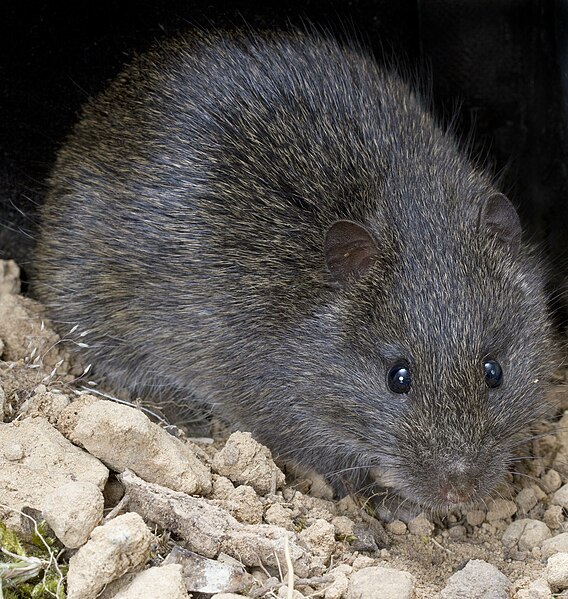The largest rats ever discovered include:
- A Gambian Pouched Rat. The largest Gambian Pouched Rat was three feet long and weighed three pounds
- Northern Luzon Cloud Rat. A Northern Luzon Cloud Rat measuring 2.5 feet, with a weight of 5.7 pounds, was discovered in the Philippines.
- Sumatran Bamboo Rat. The largest rat of its kind was 1.6 feet long and weighed a whopping 8.8 pounds.
- Bosavi Wooly Rats. These rats can grow to be 3.5 pounds and measure up to 32 inches from nose to tail.
For more common rats (i.e. roof rats, brown rats, fancy rats), they can grow up to 12 ounces and and around 20 inches long.
There are more than 60 species of rats, and they come in many different sizes, generally growing to be larger than mice. A rat’s size depends on its available food supply and species, with rat tails often growing to be longer than their bodies. Some of the most common rat species are the house rat and the brown rat. Other rats include roof rats and pack rats.
Dealing with a rat problem is no easy feat, so if you have a rat infestation, it is best to contact AAAC Wildlife Removal for effective rat control solutions. If you are interested to know more about giant rats, here is all you need to know.
Male Rats Versus Female Rats and Other Interesting Information
A male rat generally grows to be heavier and with a larger body size than that of a female rat. As per the American Fancy Rat and Mouse Association, rats became household pets more than 100 years ago. If you keep a baby rat as a pet, it may grow to be much larger than its original size. A rat can be distinguished from a mouse because it has smaller ears, a thicker tail, and a broader muzzle. They also tend to grow to much larger sizes than mice. A rat with access to an unlimited or more significant food supply can grow much larger than a rat with a restricted food supply.
Rats exist primarily to mate and exhibit foraging behavior. Most of these creatures are nocturnal, which means that they are active at night and sleep during the day. However, the brown rat is commonly alert at all hours of the day and night. Typically, rats congregate in groups known as a mischief, although its more commonly know as a “pack”. When breeding wild brown rats form a nest in an area where there isn’t already a competing pack and then form their own. The pack’s biggest male typically leads the mischief, and the group may contain several other dominant males and females.
Studies have shown that a pet rat housed in a smaller cage grew to be smaller than those housed in larger cages, indicating that a rat’s environment also has an impact on the size to which it can grow. Here are some of the most common species that can grow to enormous sizes. The largest rat species in the world exists undisturbed in the remnants of a volcano where food is abundant. Undisturbed by humans, rats can grow to surprising sizes, so if you notice a rat, it is better to take the appropriate measures as soon as possible to prevent the rat from growing. This also includes cutting off their food supply by ensuring that your property is clean and free of unattended food supplies.
Here are some of the most prominent massive rat species.
The Brown Rat or Norway Rat
The scientific name for brown rats is Rattus norvegicus or Rattus norvegicus domestica (the common pet rat or “fancy rats”). Despite being known as Norway rats, these rats are native to China and their fur is typically brown or dark grey. However, brown rats live commonly across the US and Canada. The average adult Norway rat can weigh between seven and 10 ounces or more have a tail length of more than four inches and a body length of more than 20 inches. Young rats are born underdeveloped and hairless. They weigh between 0.18 and 0.21 ounces at birth.
Adult rats have a sizable, stout body and their tails are smaller than their bodies, and they prefer living underground by burrowing. They typically live for two years, which allows them to mature into large rodents, and wild Norway rats tend to grow larger than domesticated brown rats. Norway rats can be found wreaking havoc on garbage dumps, dumpsters, grain storage areas, and sewers. These areas are where they can access food very easily. The largest brown rat ever recorded is nearly 21 inches, or two feet, in length from the tip of its nose to its tail’s tip. According to scientific evidence, the Norway rat is limited physiologically to roughly two pounds, and other species can grow to be a lot larger.

The Black Rat or Roof Rat
The roof rat (scientific name Rattus rattus) is also known as the ship rat or black rat, and these rodents are typically eight inches long and have slim bodies. These rodents have smooth coats and lighter grey fur with black shading. Their tails are dark, hairless, and scaly. Like a mouse, their tail is longer than their head and body. Their ears are large, hairless, thin, and they have pointed noses.
These creatures were commonly known as ship rats because they were known to invade ships and other human habitations. Black rats were also known to spread the bubonic plague. A decline in the number of roof rats and their displacement by brown rats is predicted to have resulted in the decline of the Black Death. However, this information has not been confirmed.
Black rats travel along tree branches, overhead pipes, rafters, utility, and power lines to enter properties. As a result of living in trees, black rats have developed a taste for fruits and nuts. They are most commonly found in coastal cities and swampy areas of the southeast. Because these animals are afraid of new things in their environment, they commonly avoid pesticides and traps.

Gambian Pouch Rats
The Gambian Pouched Rat, one of the largest rat species from the rodent genera in the world, is commonly found in Africa. They are usually around three feet long from the tip of their nose to the tip of the tail and weigh roughly three pounds and have long grey fur. These rats can be bred in captivity for up to seven years, giving them enough time to live up to their title of one of the world’s largest rat species. The Gambian Pouched Rat is known for its work in Africa, where many have been trained to detect live landmines in villages, protecting people from certain death.

The Biggest Rats on Record
The largest rats in the world can be found on remote Asian islands, in which they have grown to giant proportions because the environment is favorable, offering enough isolation, food, and warmth. Because these locations are remote, and it is hard to study these rodents in such conditions, information on the world’s largest rat may not be very accurate. Here are some of the largest rats that have been recorded.

The Bosavi Woolly Rat
As per the Smithsonian Institution, the Bosavi woolly rat is currently the world’s largest rat species. This new species of giant rat was discovered in 2009 by a Smithsonian biologist in Mount Bosavi’s crater, the remnant of a once active volcano in an area known as Papua New Guinea. The biggest rat discovered weighed about 3.5 pounds (or 2.7 feet) and was 32 inches in length, from the tip of its nose to the end of its tail. This enormous rat had a dense, silver-gray coat and was not afraid of humans. According to BBC News, the species may only exist within the remnants of this volcano, so these rat populations are not very prominent. This means that the chances of finding massive rats the size of average domestic cats are highly unlikely.
Some of the other biggest rats that have been discovered worldwide include:
- A Gambian Pouched Rat. The largest Gambian Pouched Rat was three feet long and weighed three pounds
- Northern Luzon Cloud Rat. A Northern Luzon Cloud Rat measuring 2.5 feet, with a weight of 5.7 pounds, was discovered.
- Sumatran Bamboo Rat. The largest rat of its kind was 1.6 feet long and weighed a whopping 8.8 pounds.
If you suspect that you have a giant rat problem that you cannot seem to get rid of, it may be time to get professional help.
Need Help with Your Rat Problem?
Rats aren’t just hard on the eyes. They are an invasive species also known to carry and spread diseases. Infected brown rats led to the spread of disease by transferring the infectious disease either directly, through the contamination of food sources, or indirectly through their fleas. An infected rat’s perception is no different from that of an uninfected rat, so they go about their business, as usual, causing destruction to property, and invading places where humans live, which could have potentially dangerous consequences for human inhabitants.
With rats growing to sizes of up to 2.7 feet, they should not be allowed to breed and multiply. Therefore, it is imperative that you contact a professional rat control company (like AAAC Wildlife Removal) that can trap and remove wild populations before they can grow to enormous sizes, causing damage to your home, building, or property.
The truth is that most solutions advertised online, such as pesticides and traps, simply are not effective because most rats are fearful of new things and do not investigate them. At AAAC Wildlife Removal, we are familiar with all species of rats, both large and small, and our solutions are tailor-made to every rat-infested area, so you can rest assured that a giant rat isn’t trashing your attic or kitchen in the night.
Originally published on https://aaacwildliferemoval.com/blog/rats/blog/rats/how-big-can-rats-grow/




